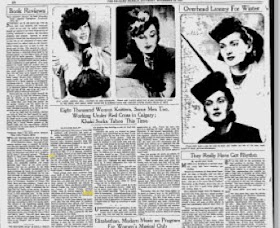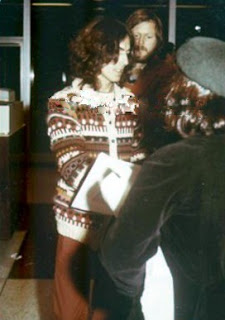
EIGHT THOUSAND WOMEN KNITTERS, SOME MEN TOO,
WORKING UNDER REDCROSS IN CALGARY;
KHAKI SOCKS TABOO THIS TIME
Probably the most outstanding of the non-organized knitters are the two men who turn in their share of socks and sweaters each week. One of these is a Great War veteran who not only learned to knit during the last war, but who has knitted his own socks ever since. He has also taught his whole family the useful art. The other is unable to walk without crutches. He learned to knit as a means of passing time, and is calling for wool regularly now. He turns in a pair of socks every week.
Although men who knit seem to be a novelty in Canada it is largely because a number of them are concealing their talent. Knitting was taught in all the hospitals during the last war. In the United States there are numerous "Leisure Hour Knitting Clubs" for men only. Probably once knitting gains [sic] popularity and ceases [sic] to be considered merely a pastime for the gossips, more men will acquire the courage to enter the feminine atmosphere of the new Red Cross Depot in the Hudson Bay Building to ask for wool and instructions.
Whether the socks are knitted by group members, busy housewives or by men, if the wool is supplied by the Red Cross they must be knitted to a certain pattern. They are knitted on number 11 needles so that if they must be washed in cold water they will not shrink into hard lumps as so many did during the last war. They are all supposed to be knitted one size; 11 inches of leg and 11 inches of foot. Many knitters have protested that since the soldiers are so many different sizes, their socks should be too. From experience the directors have learned that no two women knit alike and that no two pair of socks will be the same size. Although the sock demanded is 11 by 11 every imaginable size may be found among those turned in.
Among the 150 pairs of socks you will see almost any color except khaki. Khaki socks are taboo because it was discovered, during the last world war, that the green in the dye was harmful to the soldiers' feet when it was impossible to remove and wash the socks frequently. This time the soldiers will go to the front in heather grey, white or brown socks, but not in khaki ones.
This time too the work turned in to the Red Cross is practically perfect. Each knitter or sewer mush make her article exactly like the sample provided. There is no guess work or inaccuracy. Although anything in the way of a donation is gladly accepted and use in some phase of the work done by the Canadian Red Cross organization, all material that is issued must be made up according to specifications.
Taken from Elnora Bailey's article in The Calgary Herald, November 25, 1939













